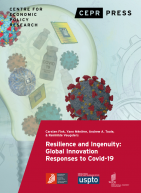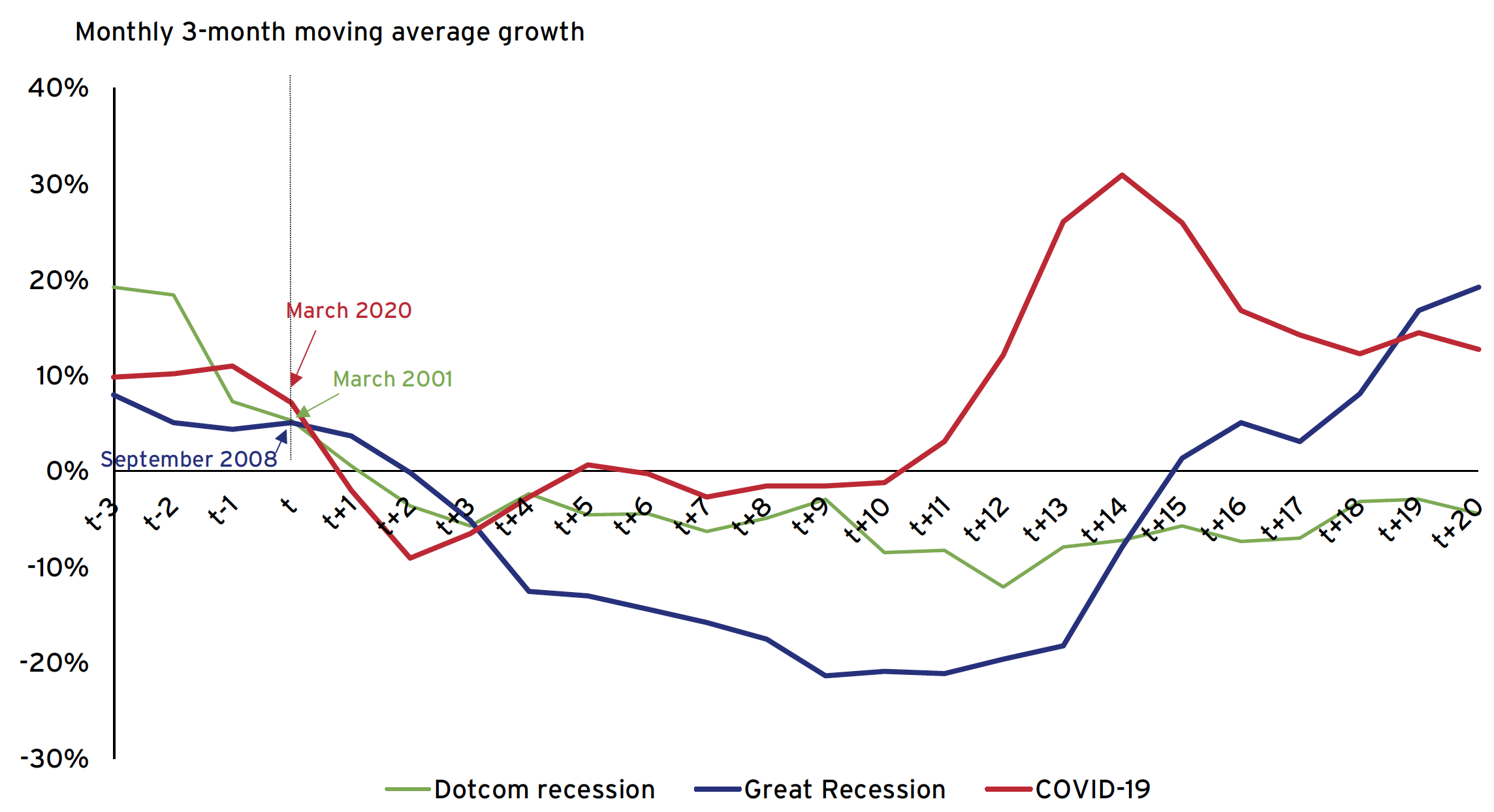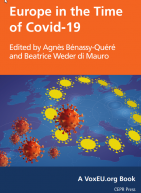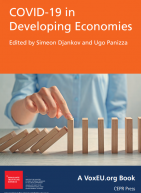The World Health Organization declared COVID-19 to be a global pandemic on 11 March 2020. Not only has COVID-19 caused massive losses to public health worldwide, it also prompted major economic havoc worldwide (e.g. Bénassy-Quéré and Weder di Mauro 2020 for Europe, Djankov and Panizza 2020 for developing countries). The decline in global GDP in 2020 turned out to be the biggest annual decline since WWII (Gopinath 2021, IMF 2021).
Previous crises have shown that innovators, despite their long-term focus, are not immune to short-term disruptions. During the 2007-2008 global financial crisis and the following Great Recession, for example, firms experienced curtailed access to finance for innovation (Lee et al. 2015) and were less able and willing to invest in innovation (Archebugi et al. 2013). Fiscal contraction in the general economy, in turn, put pressure on aggregate demand and public budgets to support research (Cruz-Castro and Sanz-Menéndez 2016). At the same time, crises can also be a catalyst for innovation, as they alter societies’ immediate and future technological needs. This was manifestly the case for innovative activity during WWII, which prompted major research efforts in the US to develop military technologies and medical treatments to support the war and laid the foundation for many postwar innovations and innovation policy (Gross and Sampat 2020).
How did the innovation system respond to the Covid-19 crisis? A new eBook from CEPR, the European Patent Office (EPO), the US Patent and Trademark Office (USTPO), and the World Intellectual Property Organization (WIPO) takes a first step toward understanding what happened in different parts of the world and how different actors in the innovation ecosystem – private and not-for-profit organisations, governments, and individuals – adjusted (Fink et al. 2022).
Impact across the world: Much similarity, some divergence
The first part of the eBook provides insights into the short-term response of innovators at the global and national levels, as captured by intellectual property (IP) application trends during the first two years of the pandemic. It draws a comprehensive picture of the unfolding of the crisis in the IP world, from which a number of important lessons emerge.
First, the impact of the pandemic on the filing of patents, trademarks and other IP rights has been less severe compared to previous crises such as the bursting of the dotcom bubble in the early 2000s or the Great Recession. Patent filings around the world were negatively hit, but declines proved shallow and short-lived – typically confined to the weeks and months following the pandemic’s onset in March 2020 (see Figure 1 for international patent applications).
Figure 1 International patent applications in crisis times
Notes: International patent applications refer to applications filed in the international phase of the Patent Cooperation Treaty (PCT). The figures presented are monthly 3-month moving average growth rates relative the same period in the previous year. Patent counts are based on the international filing date of PCT applications, either at national/regional patent offices or directly at WIPO.
Source: WIPO IP Statistics Database
The crisis nonetheless left its mark on patenting performance across economies and across technology fields. China and the Republic of Korea stand out as the least impacted economies, seeing continued growth in patenting.1 The fastest growing fields of patenting include health-related technologies (pharmaceuticals, biotechnologies, medical technologies) and digital technologies (e.g. digital communication, computer technologies). While already on the rise before 2020, the urgent needs created by the pandemic boosted innovation in these two fields. Conversely, the COVID-19 crisis aggravated the relative decline of patenting in more traditional technology sectors, such as mechanical engineering.
China and the Republic of Korea largely benefitted from this trend, thanks to their specialisation in digital innovation. Both countries showed sustained activity of large incumbent firms as well as local start-ups in this sector during the pandemic. By contrast, the relative specialisation of Germany and Japan in more traditional engineering-based industries may explain why the crisis had a more pronounced negative effect on patent filings from these two countries.
Other indicators confirm the overall resilience of innovative activities. Evidence from the US shows that R&D expenditures by companies exhibited less volatility than investments in physical capital. However, the crisis seems to have impacted some categories of smaller, budget-constrained innovators more severely. US and European SMEs often had to scale down their investments in patented innovations and reported a lack of funding for such investments. Evidence from Brazil also reveals that patenting decreased more among individual micro-entrepreneurs, micro-enterprises and small businesses than among larger companies, with one notable exception: there was a considerable uptake of utility models by local micro-entrepreneurs as the pandemic unfolded.
More broadly, many contributions to the eBook provide evidence for vibrant entrepreneurship unleashed by the crisis and fostered by the rapid adoption of digital technologies. This is evident in trademark filing trends – capturing the commercialisation of new goods and services. Figure 2 depicts the evolution of international trademark filings in the course of the three crises discussed earlier. The COVID-19 crisis stands out in showing the shallowest decline, followed by an extraordinary boom in international trademark applications about a year into the crisis. Healthcare products and ecommerce-related goods and services, broadly mirroring the patenting focus, were one key driver behind this recovery, even if the prominence of different product groups varied across economies.
Figure 2 International trademark applications in crisis times
Notes: International trademark applications refer to applications filed under WIPO’s Madrid System. Figures are presented according to the Madrid filing date.
Source: WIPO IP Statistics Database
More explicit measures of entrepreneurship – presented in the contributions from the Republic of Korea (Chapter 8) and Australia (Chapter 10) – confirm a surge in business entries and startup activity in 2021. Interestingly, a similar startup boom occurred in the midst of the Spanish flu pandemic in 1919 (Beach et al. 2020), highlighting how societal disruption generates momentum to start new activities for those entrepreneurs willing and able to take the risk amidst high overall uncertainty.
Responses in the innovation ecosystem
The second part of the eBook focuses on how different segments of the innovation ecosystem responded to the COVID-19 pandemic. One focus is the science sector. Survey evidence from the US (Chapter 12) reveals that total research time decreased substantially for all academic researchers, but these losses were not uniform across scientific fields of study or types of researchers. Women researchers and researchers with children were most heavily affected and the crisis may have permanently altered their scientific career opportunities. The chapter argues that the policy responses by academic institutions may prove insufficient to address these adverse outcomes and may have even accentuated them.
A second focus is how the biomedical innovation ecosystem responded to the crisis. Among other contributions, Chapter 15 tells the story of the mRNA Covid-19 vaccine. It highlights the difficulty of obtaining early-stage financial support for innovation. Only a handful of stubborn scientists, start-up entrepreneurs, angel investors and policy officers at the US Defense Advanced Research Projects Agency were willing to fund the high risk of the high-gain mRNA technology in its early years. In hindsight, the COVID-19 vaccines based on mRNA technologies made crucial contributions to overcoming the impacts of COVID-19, but society could easily have missed out on them.
Policy takeaways and outlook
Overall, the eBook concludes that the global innovation system proved to be resilient to the Covid-19 pandemic and its ingenuity contributed much towards addressing it. Policy support was instrumental for both.
Fiscal support measures cushioned the demand shocks, helping businesses stay solvent and workers to stay employed (Gourinchas et al. 2021). The destruction of productive intangible capital could have been far worse. Monetary policy support, in turn, enabled the continued availability of financing for innovation and fuelling the entrepreneurship wave described above (WIPO 2021). As financial conditions have tightened more recently (through 2022), the availability of risk capital has sharply declined. This raises the question of whether the loose monetary conditions and fiscal policies during the crisis generated an unsustainable degree of ‘innovative exuberance’.
A second takeaway is that policymakers should not take the ingenuity of the innovation system for granted. As already pointed out, the mRNA technology could have been easily missed by a short-sighted, risk-averse innovation support system. To be able to count on the innovation system to quickly deliver powerful solutions to societal challenges, innovation policy should take a longer-term, proactive perspective, supporting new ideas which have the potential to become breakthroughs in their early high-risk phases. Continuous investments in scientific research remain crucial in generating the knowledge underlying technological breakthroughs.
Of course, the crisis is not over at this time and our understanding of its ramifications will remain imperfect for some time to come. While most countries have lifted many of the public health measures put in place to stem the pandemic, COVID-19 mutations are still spreading around the world. The management of future infection waves may cause less disruption than during the pandemic’s first two years – thanks in large part to recent innovations in biomedical and digital solutions. However, it will surely continue to leave a mark on innovation systems.
More research is also needed to deepen our understanding of how innovators responded to the crisis. The full bibliographical details of patent applications are typically only published with a delay of 18 months. Thus, bibliographical data for patents for inventions that occurred after the pandemic’s onset have only recently become available. Future studies can thus shed more light on how different innovation stakeholders will have responded, including the effects on individual inventors and on collaboration across institutions and across countries.
References
Archebugi, D, A Filipetti and M Frenz (2013), “The impact of the economic crisis on innovation: Evidence from Europe”, Technological Forecasting and Social Change 80(7): 1247-1260.
Beach, B, K Clay and M H Saavedra (2020), “The 1918 influenza pandemic and its lessons for COVID-19”, NBER Working Paper No. 27673.
Bénassy-Quéré, A and B Weder di Mauro (2020), Europe in the Time of Covid-19, CEPR Press.
Cruz-Castro, L and L Sanz-Menéndez (2016), “The effects of the economic crisis on public research: Spanish budgetary policies and research organizations”, Technological Forecasting and Social Change 113(B): 157-167.
Djankov, S and U Panizza (2020), COVID-19 in Developing Economies, CEPR Press.
Fink, C, Y Ménière, A A Toole and R Veugelers (2022), Resilience and Ingenuity: Global Innovation Responses to COVID-19, CEPR Press.
Gopinath, G (2021), “A Race Between Vaccines and the Virus as Recoveries Diverge”, IMF Blog, 26 January.
Gourinchas, P-O, S Kalemli-Ozcan, V Penciakova and N Sander (2021), “Fiscal Policy in the Age of COVID: Does it ‘Get in all the cracks?’”, NBER Working Paper No. 29293.
Gross, D P and B N Sampat (2020), “Organizing Crisis Innovation: Lessons from World War II”, NBER Working Paper No. 27909.
IMF (2021), World Economic Outlook: Managing Divergent Recoveries, April.
Lee, N, H Sameen and M Cowling (2015), “Access to finance for innovative SMEs since the financial crisis”, Research Policy 44(2): 370-380.
Endnotes
1 As a caveat, it is important to note that the analysis of China’s innovation performance in Chapter 7 of the eBook does not consider the most recent COVID-19 wave in 2022 and its repercussions for China’s economy and innovation system.










